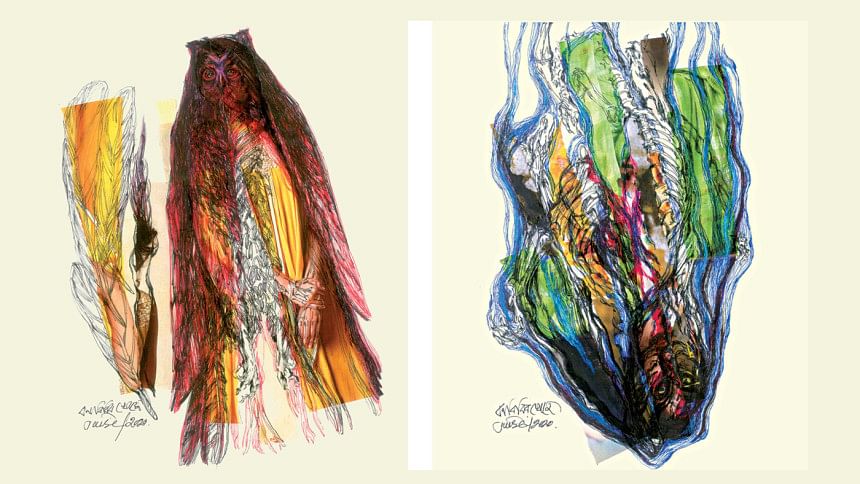‘In Quest of Bono-Bibi’: When art meets folklore

Experiencing a "kalbaishakhi jhor" inside the mangrove forest of Sundarbans can be both a spine-chilling experience or a romantic one.
In such a death-defying scenario, one cannot help but call upon the divine powers to keep them safe. Even though this is just a hypothetical scenario, if one found themselves in danger in a forest, at the sea, on the mountains and so on, sometimes the only option left is to call upon the guardian spirit of mother earth when they find themselves in times of trouble.

I am of course talking about Bon Bibi or Bono Bibi, the guardian spirit of the Sundarbans' forest-dwelling communities.
The revered lady of the forest, Bon Bibi, is now also in Dhaka.
A mixed-media exhibition by Saidul Haque Juise titled "In Quest of Bono-Bibi", organised by Kalakendra, is currently underway. Located at 9/4, Block-D, Lalmatia, the event will remain open till April 20, operating between the hours of 4:00pm to 8:00pm.
This is a must-visit exhibition because Juise, who is known for his three-dimensional progressive fine art, impeccable craftwork, and beautiful masks, is holding a solo exhibition after a long hiatus.
"Bono Bibi is simultaneously a Muslim Pirani and a Hindu goddess. As tradition goes, if you chant her name in the face of any calamity in the forest, she will protect you. Folklores of Dhukhey, Bon Bibi Dakkhin Rai, Gazi's folk tales are stories I grew up with. So, when I saw how endangered our Sundarbans have become, I began to work on the 'In Search of Bono-Bibi' series. You can say it is my way of saying sorry or paying homage to mother nature," explains Saidul Haque Juise.
You will always find an underlying tone of his political consciousness and his profound love for nature seeping into his works. In this series, he has described his work through Shlokas or verses taken from Bon Bibi literature, alongside stories written by him.
"These compositions were initially ideas I penned during the pandemic, when hope was but an elusive thing. I just tried to jot down my fleeting moments of grief, rage, and hopelessness in the pages of my sketch book, and coloured them with black, green, red, and blue inks -- the shades that represented our loud traditional colours in Bangladeshi folk pottery," Juise explains, adding that later, when he was working on the exhibition, he simply juxtaposed those sketch book paper drawings on frames.
"The whole range of work dealing with Bono Bibi are 2D artworks. Working with paint, pen and ink drawings, paper and newspaper cuttings, and using local icon symbolism, he tried to portray the mystery of the forest and the profoundness of the lady of the forest. His attempt to integrate all this through the rendering of pen and ink collages and linear drawings comes out successfully in this exhibition," according to the exhibition's foreword, written by Azyz Sharafy, professor of Electronic Arts, Studio & Graphic Design at Washburn University in the US.
"The series also features sculptures that are composed of twisted and grouped wires assimilated masterfully. At the end of the series, you are left with a lingering melody of the spirit of Bono Bibi," says Shagufta Sharmeen Tania, an expatriate poet and storyteller.
"As an iconoclast artist, Juise has continually strived to weave Bangalee art form throughout his series, with figures morphing from familiar female forms to animals, birds, and insects, embodying a fluid, organic energy, challenging our perception and explaining in a language of balanced wrath and restrained sorrow. His contemporary works are simple and unpretentious," says Shagufta while describing Juise.
His artistry lies not just in aesthetics, but in blending the form with the thought, and the style with the soul, she adds.
Juise has worked in various mediums, ranging from canvas to wood, bamboo, paper carving, wire, collage, torn paper, pen and ink, and copper and metal.
Under the scorching sun of Chaitra, Juise's imagination and depiction of Bono Bibi is the much-needed diversion that Dhaka people need right now.

 For all latest news, follow The Daily Star's Google News channel.
For all latest news, follow The Daily Star's Google News channel. 



Comments